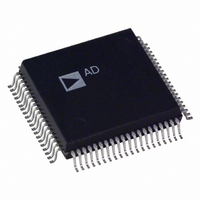AD6620AS Analog Devices Inc, AD6620AS Datasheet - Page 30

AD6620AS
Manufacturer Part Number
AD6620AS
Description
IC DGTL RCVR SIGNAL PROC 80-PQFP
Manufacturer
Analog Devices Inc
Datasheet
1.AD6620SPCB.pdf
(44 pages)
Specifications of AD6620AS
Rohs Status
RoHS non-compliant
Interface
Parallel/Serial
Voltage - Supply
3 V ~ 3.6 V
Package / Case
80-MQFP, 80-PQFP
Mounting Type
*
Applications
-
Available stocks
Company
Part Number
Manufacturer
Quantity
Price
Part Number:
AD6620AS
Manufacturer:
ADI/亚德诺
Quantity:
20 000
Company:
Part Number:
AD6620ASZ
Manufacturer:
Analog Devices Inc
Quantity:
10 000
Company:
Part Number:
AD6620ASZ-REEL
Manufacturer:
Analog Devices Inc
Quantity:
10 000
AD6620
PROGRAMMING THE AD6620
Initializing the AD6620
Before the AD6620 can be used to down convert and filter the
channel of interest it must be configured for the job. First the
RESET pin should be pulsed low for a minimum of 30 ns and
should then be returned high. This HARD_RESET of the
AD6620 clears the CIC Accumulators as well as the NCO
Phase Accumulator. When RESET is brought high the AD6620 is
removed from the HARD_RESET condition. The AD6620 is
now in SOFT_RESET. In this state the Mode Control Register
at address 0x300 contains a “1” (Bit 0 is high). When the AD6620
is in SOFT_RESET, no data is accepted by the input data port
and no processing occurs. The serial port and parallel output
port is held inactive and the chip is defined as a SYNC slave to
avoid possible contentions on these pins. While the AD6620 is
in this condition it should be programmed by the process below.
It should be noted that this initialization must be performed via
the microprocessor port since the serial port is inactive.
1. If the AD6620 is being reinitialized without performing a
2. Program the Coefficient RAM of the AD6620 with the
3. (Optional) The first piece of data out of the AD6620 is always
4. The Configuration Registers of the AD6620 are now pro-
5. The AD6620 is now ready to be removed from SOFT_RESET
HARD_RESET, then address 0x300 should be written 1 to
place the AD6620 in SOFT_RESET. This allows the non-
dynamic registers to be programmed.
desired FIR Filter. The address auto-increment feature can
be used to decrease the amount of time required to program
the Coefficients. This feature is described in detail in the
Microport Control section that follows.
zero due to an output pipeline delay. There will also be a
start-up glitch on the output of the AD6620 due to possible
nonzero data in the I and Q data RAMS of the RCF filter.
These RAMS are not initialized by the HARD_RESET. If
this is a concern then the data RAMS should now be written
to zero. For efficiency the auto-increment feature can be
used as with the programming of the coefficient RAMs.
grammed. First, address 0x300 should be written to set the
Operating Mode if Diversity Channel Real or Single Channel
Complex Modes are used. Bit 0 of this register should remain
high at this time. This will hold the SOFT_RESET condition.
The remaining configuration registers can now be programmed.
This should start at address 0x301 and continue to address
0x30D. This defines the operation of the NCO and filter stages.
and allowed to process data. This is done by writing address
0x300 to again set the desired mode of operation. This loca-
tion should be set for SYNC MASTER or SYNC SLAVE
operation at this time. Bit 0 of this register is written low at
this time to remove the SOFT_RESET condition.
Dynamic Programming of the AD6620
Many attributes of the AD6620 may be altered dynamically as
the AD6620 processes the received data. This allows the receiver
to be adjusted during operation in order to achieve the maxi-
mum performance. The typical dynamic registers of the AD6620
are listed in the following table. To program the other registers
follow the steps described in the section titled Initializing the
AD6620. Technically all registers can be programmed dynami-
cally, but adverse results may occur if registers other those listed
are written dynamically.
These addresses may be programmed via either the Micropro-
cessor or the Serial Control Ports.
Address Bit Width
302
303
304
305
307
309
30B
Registers 0x302, 0x303 and 0x304 allow the NCO of the AD6620
to be adjusted. The tuning frequency can be dynamically changed
for frequency hopping. The phase of the carrier can be adjusted
with address 0x304. The phase accuracy of the synchronization
can be changed with 0x302. Registers 0x305, 0x307, and 0x309
allow the user to dynamically control the gain of the AD6620 in
6 dB increments. This can be used to maximize the AD6620s
dynamic range for the signal being tuned at a particular instant.
Register 0x307 allows for AGC where the DSP does power
spectral estimation.
In addition to dynamically writing to these registers, they may
also be read to verify program content. Care should be taken,
however, because reading some registers may affect normal chip
operation. In particular, reading from 303h the NCO frequency
will cause the phase accumulator to be reset via the SYNC_NCO
pulse if the AD6620 is running as a Sync master. If the device is
run as a Sync slave, then the phase accumulator is not reset.
Addresses 000h through 1FFh should not be read dynamically
as doing so will disrupt the internal state machine computing
the FIR taps. These locations may be read statically if needed.
32
32
16
8
5
4
8
Table X. Dynamic AD6620 Registers
Name
NCO SYNC CONTROL REGISTER
NCO_FREQ
NCO PHASE_OFFSET
INPUT/CIC2 SCALE REGISTER
CIC5 SCALE REGISTER
OUTPUT/RCF CONTROL REGISTER
RCF ADDRESS OFFSET REGISTER













